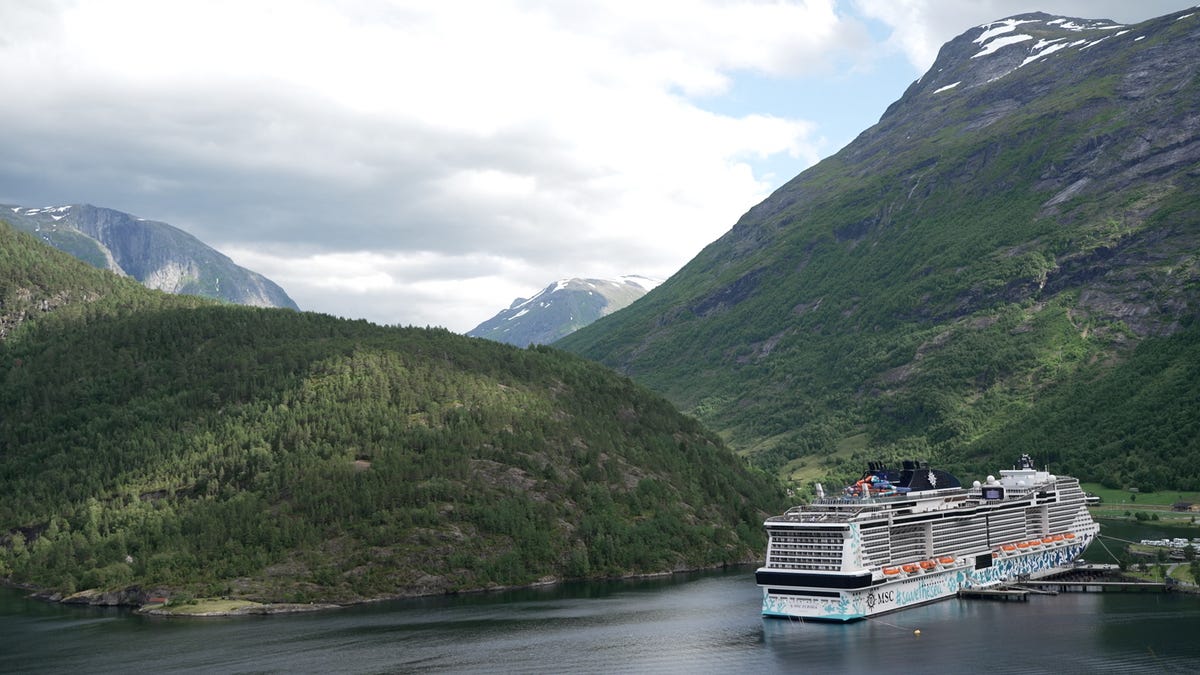
How to travel more sustainably
Travel more sustainability with these eco-friendly tips.
ProblemSolved, USA TODAY
Starting in 2026, Norway will implement zero-emissions requirements for ships in its fjords.The regulations aim to reduce air and noise pollution from cruise ships and protect the natural environment.The rules will initially apply to smaller passenger ships, with larger vessels facing requirements from 2032.
Ashley Correia stood on the pool deck of a Celebrity Cruises ship taking in the scenery in late May. But rather than sunny ocean views, the 42-year-old saw streams of water cascading down mountains on either side of the Celebrity Apex.
The ship was sailing past the Seven Sisters waterfall in Norway’s Geirangerfjord. “Everywhere you looked was just like a screensaver from a computer,” she said of her trip.
The Berkley, Massachusetts, resident joined her mother on a cruise through Norway’s fjords – as well as a stop in Belgium – after her father unexpectedly passed away. Correia, who owns a liquor promotions company and makes travel content on TikTok, has taken cruises before, including to see glaciers in Alaska, but found the Norwegian voyage “was almost like the Alaskan cruise on steroids.”
“It was just so much more (grand),” she said.
Norway is taking steps to keep it that way. The country will enact new zero-emissions requirements for passenger ships beginning in 2026, aimed at reducing the vessels’ environmental impact and potentially providing a model for more sustainable cruise tourism. That could have an impact on cruisers’ travel plans, too.
What are Norway’s zero-emissions requirements?
The zero-emissions requirements will apply to the West Norwegian Fjords, Geirangerfjord and Nærøyfjord, among the longest and deepest fjords in the world. The sites were added to the UNESCO World Heritage List in 2005.
The rule requires that “energy sources used must not result in direct emissions of carbon dioxide (CO2) or methane (CH4),” according to a policy document from the Norwegian Maritime Authority. “Fuels that generate direct emissions of greenhouse gases may be used to the extent necessary to ignite the energy sources. If nitrous oxide (N2O) is generated through the use of energy sources that meet the zero-emission requirement, the vessel shall use the best available technology to reduce such emissions.”
Passenger ships will also be required to plug into shore power where available.
The rules will apply to passenger vessels under 10,000 gross tonnage starting on Jan. 1, 2026, and those 10,000 gross tonnage or more on Jan. 1, 2032 (the changes were originally set to take effect for all ships in 2026 but were delayed for larger vessels).
How will the zero-emissions requirements help the environment?
Helene Muri, an adjunct senior researcher at the Norwegian University of Science and Technology’s Department of Energy and Process Engineering, said that large ships in particular have “been increasingly affecting these beautiful fjords.”
CO2 emissions contribute to global warming, for starters. And while other regulations in the fjords have cut down on air pollution from sulfur, others, such as ozone formed as a result of nitrogen oxide emissions – which is a pollutant when it appears near the ground – can cause respiratory problems in humans and impact crops and other plants.
“Within these fjords, you have these kinds of narrow gateways, usually, with very steep mountains diving down into the fjords,” said Muri, who is also a senior scientist at NILU, an independent climate and environmental research institute. “So, the emissions from the ships tend to get kind of trapped within the fjords, so the air quality will be polluted, as well.”
Noise from the ships can also disturb wildlife, and the vessels – especially larger ones – have been criticized for “visual pollution,” according to Muri.
“It’s the same kind of argument sometimes against wind turbines,” she said. “Like, it doesn’t look so nice in the serene and beautiful nature.”
Some cruise operators may have an easier time complying than others. Hurtigruten and Havila Voyages, for example, already have battery-hybrid-powered ships. While the industry is aggressively exploring alternative fuels, though, those are not yet widely available.
Small passenger ships that cannot meet the requirements in time may be eligible for temporary exemptions from the Norwegian Maritime Authority, and larger vessels have years to adapt their technology. “Nevertheless, many cruise companies have reported that they anticipate significant challenges in complying with the regulations once they take effect,” the policy document reads.
Cruise Lines International Association, the industry’s leading trade organization, told USA TODAY that the “transition is intended to be gradual, recognizing that technology for larger ships is still under development.”
Nearly every cruise ship operating in Norway can use renewable, low-carbon fuel, according to CLIA; however, these are not yet accessible at the necessary scale. “Rapid decarbonization of cruise and maritime transport is possible with the right investment in place,” the organization said in an email. “Cruise lines are pursuing net-zero emissions by 2050, and such initiatives signal the industry’s commitment to be an active partner in the development of sustainable tourism.”
Helga Maria Sulen Sund, Senior Communications Advisor with the Norwegian Maritime Authority, said it did not have data on how many ships operate in Norway annually.
Norway cruise tips
A wide range of operators sail in Norway, from mainstream cruise lines carrying thousands of guests at a time, such as Celebrity and Princess Cruises, to smaller expedition operators like National Geographic-Lindblad Expeditions and HX.
Cruises departing from Norway typically leave from Oslo or Bergen, according to Kristin Winkaffe, a luxury travel designer and founder of Winkaffe Global Travel. Many itineraries that visit the Scandinavian country also sail from Southampton, England.
Cruises typically operate there between May and September – though some ships still sail coastal routes during other times – and can be a particularly nice way to see the country. “It’s just otherworldly nature,” Winkaffe said. “You have really cool opportunities for a lot of great off-the-beaten-path experiences. There’s a lot of really, really tiny towns and villages that you can get to when you’re doing a cruise, as opposed to a land itinerary.”
She warned that passengers could see changes to their itineraries due to the new regulations, but cruise lines’ customer service departments should be able to address questions about that. “And if they’re not prepared to answer those questions, then that’s kind of an answer in and of itself,” Winkaffe added.
Muri acknowledged that achieving zero emissions on cruise ships remains “a work in progress.”
“These kinds of laws and regulations are really a step in the right direction, and I really hope that cruise operators will now really make an effort to do something about their emissions,” she said.
Nathan Diller is a consumer travel reporter for USA TODAY based in Nashville. You can reach him at ndiller@usatoday.com.
